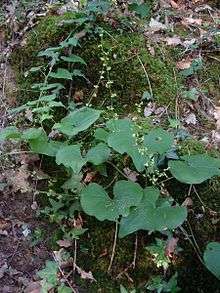Dioscorea communis
| Black bryony | |
|---|---|
 | |
| Scientific classification | |
| Kingdom: | Plantae |
| (unranked): | Angiosperms |
| (unranked): | Monocots |
| Order: | Dioscoreales |
| Family: | Dioscoreaceae |
| Genus: | Dioscorea |
| Species: | D. communis |
| Binomial name | |
| Dioscorea communis (L.) Caddick & Wilkin | |
| Synonyms[1] | |
| |
Dioscorea communis (sometimes placed in the segregate genus Tamus) is a species of flowering plant in the yam family Dioscoreaceae and is commonly known as black bryony, lady's-seal, and black bindweed.[2]
Description
It is a climbing herbaceous plant growing to 2–4 m tall, with stems that twine clockwise.[3]:102 The leaves are spirally arranged, heart-shaped, up to 10 cm long and 8 cm broad, with a petiole up to 5 cm long. It is dioecious, with separate male and female plants. The flowers are individually inconspicuous, greenish-yellow, 3–6 mm diameter, with six petals; the male flowers produced in slender 5–10 cm racemes, the female flowers in shorter clusters. The fruit is a bright red berry, 1 cm diameter. Its fairly large tuber is, like the rest of the plant, poisonous.
Distribution
Dioscorea communis is a native spontaneous species widespread throughout southern and central Europe, northwest Africa and western Asia, from Ireland to the Canary Islands, east to Iran and Crimea.[1][4][5][6][7][8]
Habitat
Dioscorea communis is a typical plant of the forest understory, from the sea to the mountains, usually in dense woods, but it can also be found in meadows and hedges.
Uses
According to secondary sources, all components of the black bryony plant, including the tubers, are poisonous due to saponin content. Therefore, it is not typically used internally; however, it has been used as a poultice for bruises and inflamed joints. It has been suggested that black bryony be used topically with caution, due to a tendency for the plant to cause painful blisters.
Studies have isolated calcium oxalate deposits and histamines in the berry juice and rhizomes, which may contribute to skin irritation and contact dermatitis associated with black bryony.[9]
Black Bryony is highly poisonous and should not be ingested at all.
Chemistry
The rhizome contains phenanthrenes (7-hydroxy-2,3,4,8-tetramethoxyphenanthrene, 2,3,4-trimethoxy-7,8-methylenedioxyphenanthrene, 3-hydroxy-2,4,-dimethoxy-7,8-methylenedioxyphenanthrene, 2-hydroxy-3,5,7-trimethoxyphenanthrene and 2-hydroxy-3,5,7-trimethoxy-9,10-dihydrophenanthrene).[10]
Gallery
-

Illustration from Flora von Deutschland, Österreich und der Schweiz 1885
-

Plant of Dioscorea communis
-
Fruits of Dioscorea communis
-
Close-up of fruits of Dioscorea communis
-

Fruits and seeds
-
Young shoots - edible part of black bryony
References
- 1 2 Kew World Checklist of Selected Plant Families.
- ↑ USDA GRIN Taxonomy, retrieved 31 March 2015
- ↑ Blamey, M.; Fitter, R.; Fitter, A (2003). Wild flowers of Britain and Ireland: The Complete Guide to the British and Irish Flora. London: A & C Black. ISBN 978-1408179505.
- ↑ Altervista Flora Italiana, Tamaro, Dioscorea communis (L.) Caddick & Wilkin includes photos plus European distribution map
- ↑ Govaerts, R., Wilkin, P. & Saunders, R.M.K. (2007). World Checklist of Dioscoreales. Yams and their allies: 1-65. The Board of Trustees of the Royal Botanic Gardens, Kew.
- ↑ Dobignard, D. & Chatelain, C. (2010). Index synonymique de la flore d'Afrique du nord 1: 1-455. Éditions des conservatoire et jardin botaniques, Genève.
- ↑ Blamey, M. & Grey-Wilson, C. (1989). Flora of Britain and Northern Europe. Hodder & Stoughton. ISBN 0-340-40170-2.
- ↑ Flora Europaea: Tamus communis distribution Royal Botanic Garden Edinburgh, Inverleith Row, Edinburgh, EH3 5LR, United Kingdom(2008).
- ↑ http://www.mangosmarket.com/ns/DisplayMonograph.asp?StoreID=D9339NK282S92NV700AKHLBD3LHF7NV2&DocID=bottomline-blackbryony
- ↑ Phenanthrenes and a dihydrophenanthrene from Tamus communis and their cytotoxic activity. Adriána Kovácsa, Peter Forgob, István Zupkóc, Borbála Réthyc, György Falkayc, Pál Szabód and Judit Hohmanna, Phytochemistry, Volume 68, Issue 5, March 2007, Pages 687–691, doi:10.1016/j.phytochem.2006.10.028
External links
| Wikimedia Commons has media related to Dioscorea communis. |
| Wikispecies has information related to: Dioscorea communis |